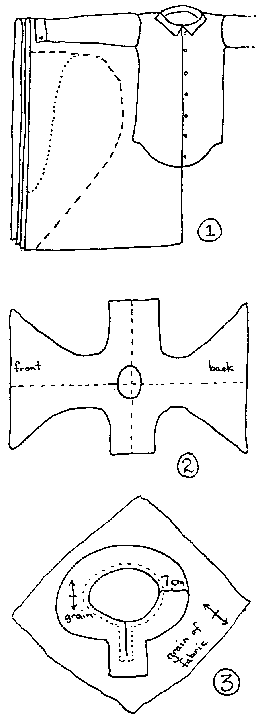 Making a Simple Tunic
Making a Simple TunicWhat to Wear
(How do you lace this thing?)
A basic requirement for attending a Society event is that you wear appropriate costume. In general, this means clothing from Medieval or Renaissance Europe (i.e., pre 1600), although some other cultures such as Middle Eastern and Russian are also included, plus some exotics (e.g., Mongol, Hindu, African) as visitors. To begin with, you may be able to put something suitable together out of what you have in your wardrobe, or make a simple, inexpensive outfit if you know how to sew.
If you don't have anything suitable, you can borrow costumes (called garb) from the Hospitaller - a local person who helps newcomers (see Officers). If you borrow garb, you may need to leave a small deposit or your driver's licence as security. Ask if you need to get the garb you borrow cleaned and/or mended afterwards (though often the Hospitaller will do this). If you are asked to clean things, be careful - some fabrics or trims can be destroyed by machine washing and need hand washing or dry cleaning. Check first! (This applies if you borrow garb from a friend as well - they may not think to tell you not to machine-wash velvet...)
Some parts of people's costumes indicate rank or position and shouldn't be used by anyone else. For example, Royalty wear crowns or coronets as symbols of their rank. Anyone can wear a narrow fillet or metal headband, as this was common in some places in the Middle Ages, but it shouldn't have points like a crown. Knights wear a plain white belt as the major symbol of their knighthood, so you should not wear one. Peers may wear an open-linked chain as symbol of their peerage, so you should avoid this too. Many squires wear red belts and apprentices green belts, but these are not actually restricted. There are no restricted colours for other clothes. If you're not sure, ask an SCA member.
Most SCA people make their own clothes, or get another member to make something for them. Unfortunately, you cannot just trot into DJs or K-Mart and ask for "Renaissance Italian, size 12, please".
Don't worry if you can't sew. We'll teach you! Many people around the Barony have patterns for basic clothes, and instructions for making a simple tunic ("T-tunic", so called because of its shape) are given in this booklet. Beginners' classes are usually held at the colleges near the start of the University year, and other sewing days may be held through the year on demand.
If you see someone wearing something you like, go up and ask them about it. If they made it themselves, they will probably be willing to help you make one too, or if not, they can point you at someone who can. You can often get someone to make a simple tunic in return for help on one of their projects or some similar service; several people in the Barony will make more complicated clothes for relatively modest fees.
Costuming is a highly flourishing branch of the SCA Arts & Sciences. Since the SCA covers a wide time range (from about 600 up to 1600) and all of Europe, plus visitors from elsewhere, there is a vast array of clothing styles to choose from, as simple or as fancy as you please. However, until you have had a chance to see what's available and settle on a style you like, you will need something to wear to your first few events which doesn't look too modern. Below are some guidelines which will help you achieve a medieval look for your first garb; they are not intended to be a precise description of medieval clothes. The general style is an approximation of what was worn in England around the 1200s or earlier, though the basic women's garment with close-fitting sleeves remained as an underdress well into the 1400s through much of Europe. Of course, it's even better to find out what people actually wore, and the best way to do this is to look at paintings from the period or books about the Middle Ages, or the better books on history of costume. Many people in the Barony have excellent libraries and are happy (and eager!) to let you come over and browse.
Fabric
Choose plain fabrics until you have looked at enough pictures to know what medieval patterns were like; they were different from many modern ones (any flower print, for example, will almost certainly look modern). Stick with cotton, linen, wool, or silk.
Cotton drill and head-cloth are cheap and reasonable approximations to the more common linen of the Middle Ages. Avoid knit fabrics - they were not known in the Middle Ages and always look modern. Some polyesters look quite like silk, but most of them do not, especially in large amounts.
Colour
Choose a strong colour and avoid pastels, dayglo orange, lime-green, and shocking pink. Rich crimson, golden yellow, royal blue, or forest green always look good. You can dress up your clothes by wearing layers (e.g., a long green underdress with a shorter red overdress), or by trimming them with simple embroidery around the neck and sleeves. A couple of simple embroidery suggestions are given later in this section.
For men, a collarless tunic any length from ankle- to mid-thigh is suitable, with long or short sleeves (longer tunics tend to have longer sleeves). You can leave your legs bare or wear hose (opaque tights). If you prefer to wear pants, they should be dark in colour and baggy rather than tight (like sweat pants). Always wear your tunic over your pants, never tucked inside like a shirt.
Boots, sandals, or plain dark shoes are appropriate ("Kung-Fu" shoes from Chinatown are a reasonable, cheap, first approximation to medieval shoes). A leather belt, a pouch to hang from it, and maybe a dagger to stick through it are nice touches. For headgear, you can leave your head uncovered or wear something like a "Robin Hood" style hunting cap (see the pattern at the end of this section).
For women, dresses should be floor length or longer (not calf- or ankle-length) and have long sleeves. No lady showed her bare forearms in the Middle Ages - this would have been quite shocking! A pattern with a scoop neck, no bust darts, and long flowing lines is good for first garb. You can make the sleeves close-fitting, or have them loose and flowing at the wrists. Simple clothes generally were fairly tightly-fitted around the bust, loose around the hips, and very wide at the hem. Belts tended to be worn around the hips rather than around the waist, though in the styles of the 1400s belts had moved up to just under the bust (see the illustrations of houpellandes and V-necked gowns at the end of this section).
Most medieval shoes did not have heels (until you get to Elizabethan times), so wear plain, flat shoes, preferably with pointed toes. "Kung-Fu" or folk dancing shoes are both reasonable approximations. For most of the Middle Ages, grown women covered their hair and only young maidens or harlots wore their hair loose. A white veil, held on with a band of braid, a simple circlet, or a padded roll is good basic head covering. If you're into hats, there is a wonderful variety of head coverings available, depending on time and place.
If the insistence of covering up seems extreme, remember that not only was morality strict in the Middle Ages, but the climate of Europe is cold! If you were living in a manor with stone walls and no central heating, with a metre of snow on the ground outside, you'd be most grateful for long skirts, long sleeves, and headgear.
Both men and women wore hose (stockings) on their legs. In earlier times these were fine wool or linen bias-cut to provide some stretch, and late in period they were knitted. Long plain cotton socks, opaque tights, or leggings are all good equivalents.
Well, no-one can see what you are wearing under your garb, so the following is mostly for interest, since it's a subject you rarely see much information on (although, by the way, the medievalness of most women's' clothing is noticeably different depending on whether or not the lady is wearing a bra). Incidentally, a certain amount of casual nudity seems not to have been a big deal in the Middle Ages. You can find paintings of male peasants working in the fields in a shirt and nothing else, village lads swimming naked while noble pleasure parties ride by, or both sexes sitting by the fire holding up their tunics to the warmth, showing all they've got. Similarly, there are many paintings of men and women bathing together in outdoor tubs, or of noble ladies at their bath attended not only by their women, but by young men playing music or offering wine.
As underwear, early in period men wore an under-tunic of fine, soft, unbleached linen, which by later times had become a shirt with long full sleeves. In earlier times, when hose were short (around knee-length), men typically wore nothing or a loincloth - a long rectangle of soft linen simply wrapped a couple of times around the hips, tucked over and down through the band at the back, passed under the crotch from rear to front, and the end tucked in at the top. Alternatively, they wore very loose linen breeches like badly cut boxer shorts, held in place by a band around the top edge called a breechclout. As time progressed, the loincloth and breeches developed into a pair of low cut under-shorts with short legs and a drawstring fly. However, when hose became longer and nearly reached the top of the thighs, these under-shorts were often omitted. (The tops of the hose were laced to the bottom of an undervest, or paltock). Since outer tunics were getting very short at this stage, this led to an outcry against the immodesty of these modern young men, and eventually hose began to be made a little longer and joined along the crotch. As a slit was left in the front seam, something was required to cover it when tunics got even shorter and stopped just below the waist, leading to the codpiece. This reached its greatest elaboration in Elizabethan times, with some quite amazing, er, erections.
Early in period women wore a long (ankle or mid-calf length) singlet of fine, soft linen. This developed into a very full long-sleeved chemise (shirt), though the singlet style might still be worn under a close-fitting underdress. The top edge of the chemise was visible in many clothing styles, and was often decorated. Puffs of the sheer, full chemise sleeves were pulled out though slits in the outer gown sleeves, or between sleeve sections, in some styles (e.g., early 1500s German, Italian Renaissance). As skirts got fuller, increasing numbers of petticoats were added to push them out, and eventually padded bumrolls and elaborately hooped constructions were created to achieve the conical Tudor and drum-like outline of Elizabethan skirts.
There was no direct equivalent of a bra for women; clothes were tightly laced around the bust, or designed with breastbands to provide support. Once you are used to having relatively tight clothing across your ribs, a breastband can be more comfortable than a modern bra (especially for generously endowed women), as there is no drag from narrow shoulder straps. Corsets started to be worn around the time the Tudor period began, and continued on up to modern times in one form or another. A well made corset is confining but not particularly uncomfortable, though most ladies with later personas say they are grateful to unlace theirs at the end of an event! Underpants for women are a quite modern invention; they were not worn at all in period.
The following directions assume that you already have some sewing experience and have made yourself clothes before. If you haven't, you will need hands-on help from an experienced sewer.
For a simple tunic, see if you can find material 150cm wide rather than 110-115cm, as this will make it easier to do the sleeves. Buy twice the length you would like to have the tunic, plus a little bit for the hem. For example, if you are a lady 165cm tall and are going to make a floor-length underdress (as opposed to a mid-calf overdress), you will need twice your height from shoulder to floor plus 10cm or so for hems - say 2 x 135 + 10, which is 2.8m. Most women will be able to make a floor-length gown from 3m of fabric. On the other hand, if you are a lord and would like a tunic that comes just above the knee, 2m should suffice. If your material is narrow and you are going to make long sleeves, you may need to get an extra 0.5m to cut sleeve extensions from.
For your pattern, take a long-sleeved shirt or any garment you can get into without undoing. Fold your fabric in quarters and lay the shirt down on it as in Diagram 1. Draw a line around the outside of the shirt, leaving plenty of room under the armpit. Cut the bottom of the skirt out as least as wide as the sleeve width. You can make the sleeves straight or long and flowing; both cutting lines are shown in Diagram 1.
Mark the edges of the neck hole with pins, but don't cut it yet. Cut out around your outlines, spread the tunic out as in Diagram 2, and check the width of the neck opening. It's important not to make it too wide - it should not be any wider than your handspan
Zigzag all the side seams of your tunic, fold it over as shown in Diagram 4, and stitch the side seams 1.5cm in from the edges. Iron the seams out flat. Hem the bottom and seams out flat. Hem the bottom and the sleeves, and you're done.
from tip of little finger to tip of thumb. Draw a nice oval for the neck, a little deeper in front than at the back as in Diagram 2, and cut it out. Make a 6cm slit down the centre front, as shown.
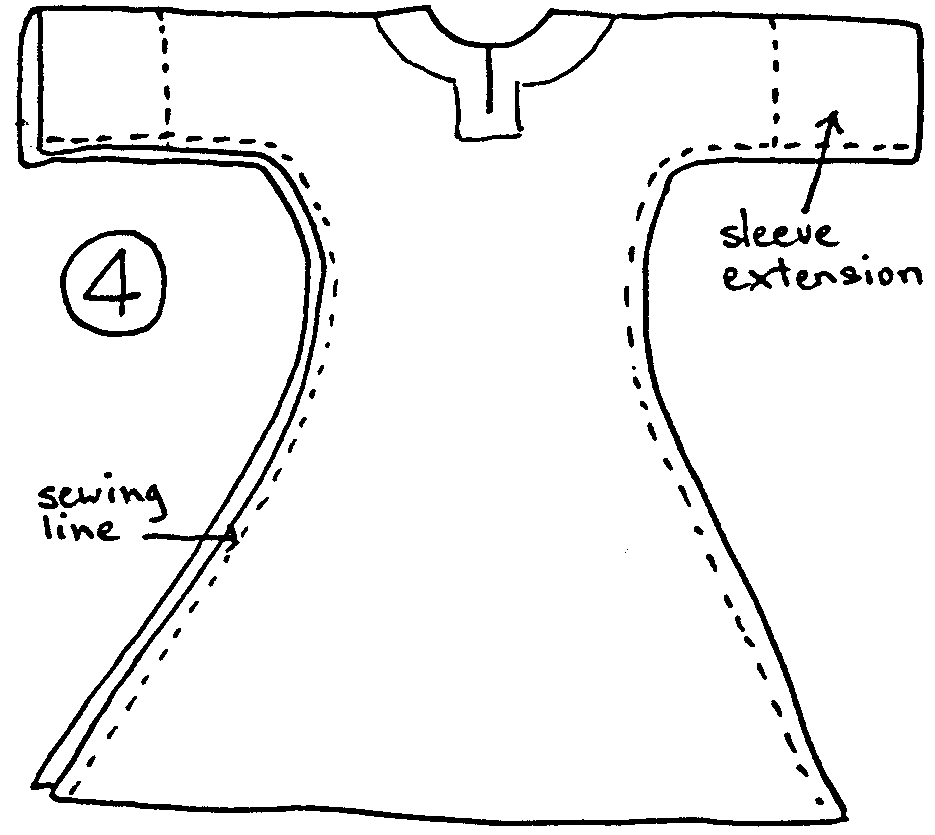 Cut a
keyhole-shaped facing on the bias from your leftover fabric as in Diagram 3,
finish the outside edges to prevent fraying, and face the neck. Clip the curves
and the bottom of the front opening, cut off the top corners at the front
opening, and turn the facing to the inside. If you are confident, you might like
to make the facing in a contrasting colour, turn it to the outside instead of
the inside, and sew it down neatly. This will give you a very pleasing neck
accent. A band of the same contrast colour around the bottom of the tunic looks
good, too.
Cut a
keyhole-shaped facing on the bias from your leftover fabric as in Diagram 3,
finish the outside edges to prevent fraying, and face the neck. Clip the curves
and the bottom of the front opening, cut off the top corners at the front
opening, and turn the facing to the inside. If you are confident, you might like
to make the facing in a contrasting colour, turn it to the outside instead of
the inside, and sew it down neatly. This will give you a very pleasing neck
accent. A band of the same contrast colour around the bottom of the tunic looks
good, too.
If your fabric was too narrow for long sleeves and you are a lord, you can just leave your sleeves short. If you are a lady, however, you really need longer sleeves. You will have to cut sleeve extensions from your spare material, and join them to the ends of the tunic sleeves before you sew the side seams. See if you can cut the extensions so that the selvedges will be together, so you needn't finish the raw edges.
You may like to run some embroidery around the neck to keep the facing down, or around the arms to hide any sleeve extension seams. A couple of simple patterns are shown below.

Tunic Variations:
Shoes, hat, veils: here are simple patterns for shoes, and a "Robin Hood" hat, plus drawings of some veil types. You can make a veil from an oval or rectangle of light white cloth about 1.5m x 0.75m.
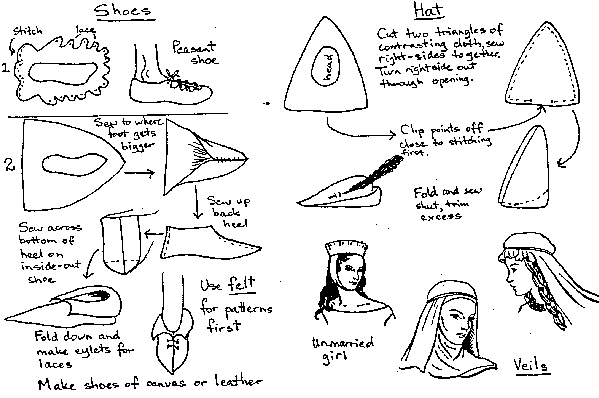
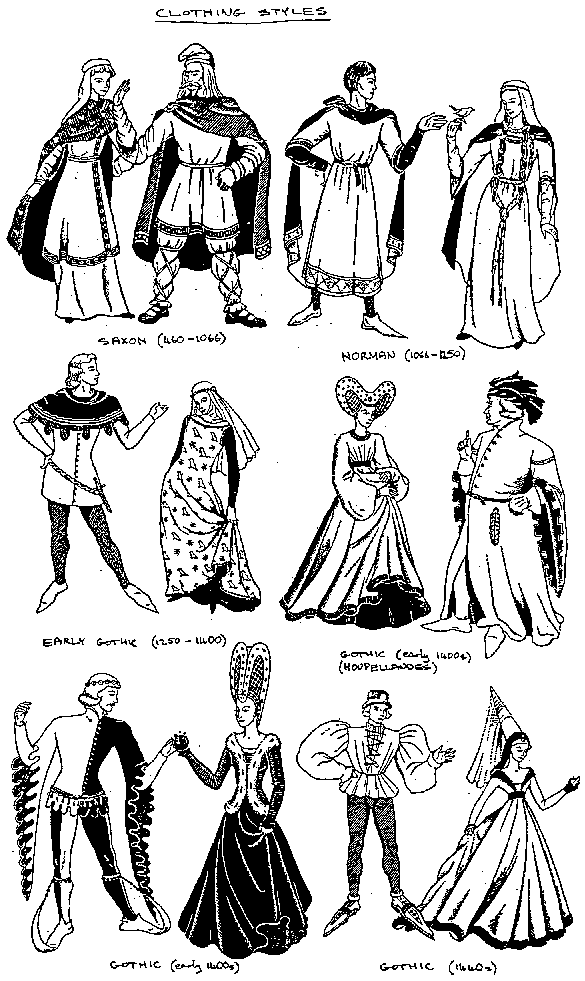
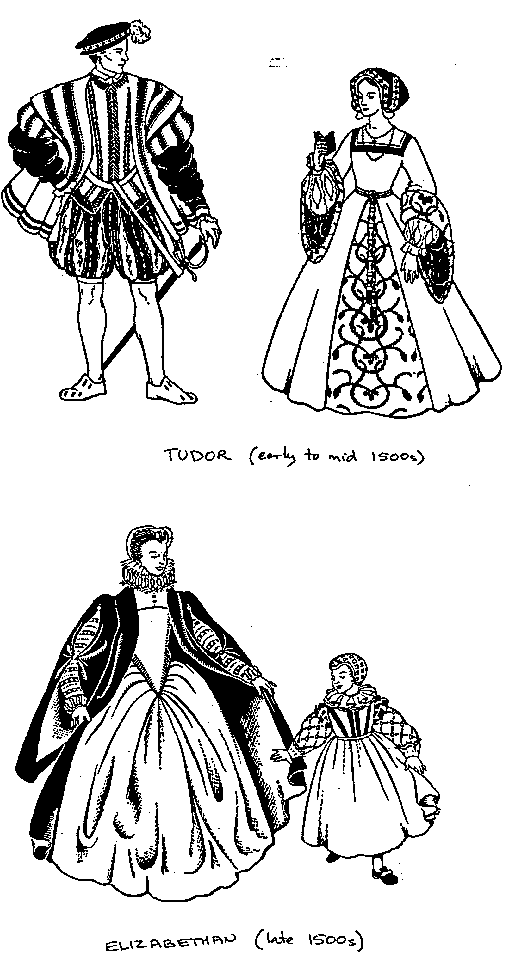
|
Please refer to the section on
Copying this Booklet for
information on rights reserved by the authors. |